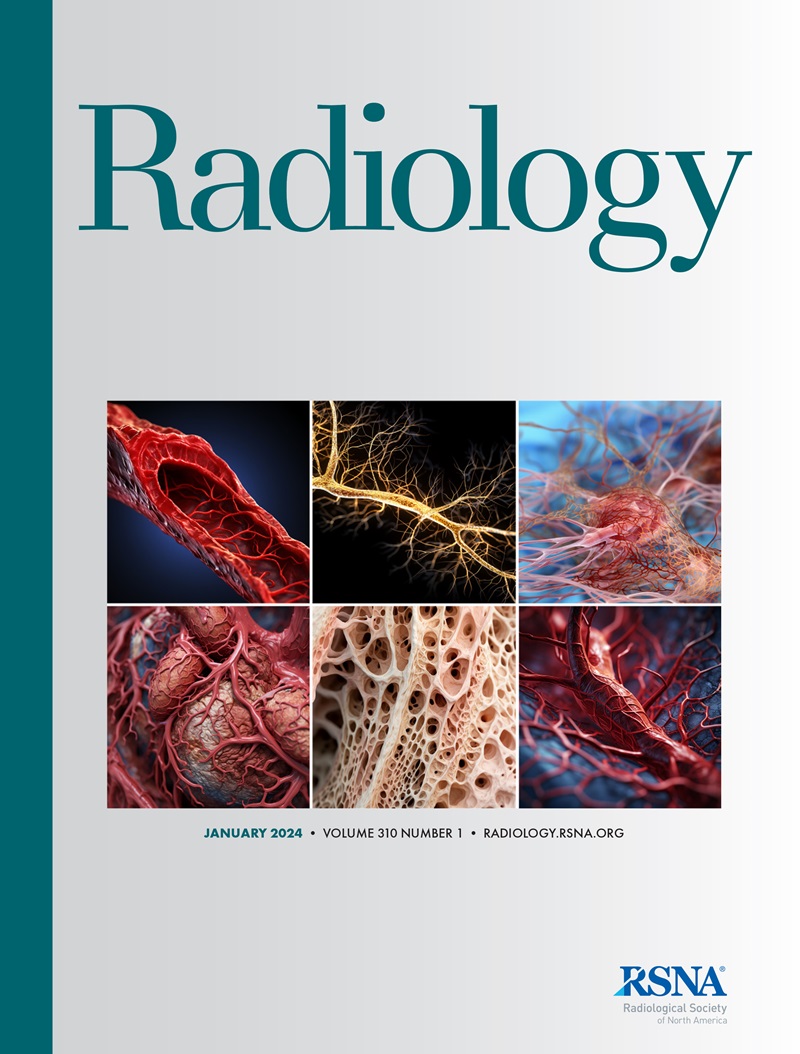Contrast-enhanced US of High-Risk Indeterminate Focal Liver Observations Categorized as LR-4 or LR-M at CT/MRI.
Andrej Lyshchik, Cristina Kuon Yeng Escalante, Tania Siu Xiao, Fabio Piscaglia, Yuko Kono, Alexandra Medellin-Kowalewski, Shuchi K Rodgers, Virginia Planz, Aya Kamaya, David T Fetzer, Annalisa Berzigotti, Iuliana-Pompilia Radu, Paul S Sidhu, Corinne E Wessner, Kristen Bradigan, John R Eisenbrey, Flemming Forsberg, Stephanie R Wilson
下载PDF
{"title":"Contrast-enhanced US of High-Risk Indeterminate Focal Liver Observations Categorized as LR-4 or LR-M at CT/MRI.","authors":"Andrej Lyshchik, Cristina Kuon Yeng Escalante, Tania Siu Xiao, Fabio Piscaglia, Yuko Kono, Alexandra Medellin-Kowalewski, Shuchi K Rodgers, Virginia Planz, Aya Kamaya, David T Fetzer, Annalisa Berzigotti, Iuliana-Pompilia Radu, Paul S Sidhu, Corinne E Wessner, Kristen Bradigan, John R Eisenbrey, Flemming Forsberg, Stephanie R Wilson","doi":"10.1148/radiol.240916","DOIUrl":null,"url":null,"abstract":"<p><p>Background Indeterminate focal liver observations in patients at risk for hepatocellular carcinoma (HCC) may require invasive biopsy or follow-up, which could lead to delays in definitive categorization and to postponement of treatment. Purpose To examine clinical effect of contrast-enhanced US (CEUS) in participants with high-risk indeterminate liver observations categorized as Liver Imaging Reporting and Data System (LI-RADS) category LR-4 (probably HCC) or LI-RADS category LR-M (probably or definitely malignant but not HCC specific) at CT or MRI. Materials and Methods This was a secondary analysis of a prospective international multicenter validation study for CEUS LI-RADS (January 2018 to August 2021). CEUS was performed within 4 weeks of CT or MRI. Tissue histologic and CT or MRI follow-up data were used as reference standards. Clinical effect of CEUS for HCC was evaluated in observations 10 mm or larger categorized as CT/MRI LR-4 and LR-M. Results Included were 109 participants (mean age, 64.3 years ± 8.3 [SD]; 68.8% [75 of 109] male participants) with 113 observations (≥10 mm) categorized as CT/MRI LR-4 (53.1%; 60 of 113) or LR-M (46.9%; 53 of 113). CEUS resulted in management recommendation changes in 33.6% (95% CI: 25, 43; 38 of 113) of observations; among these, 95% (95% CI: 82, 99; 36 of 38) were correct. A total of 30.1% (34 of 113) of CT/MRI LR-4 and LR-M observations were categorized at CEUS as LI-RADS category LR-5 (definite HCC), making biopsy unnecessary; 94% (32 of 34) of these categorizations were correct. Of CT/MRI LR-4 observations, 7% (four of 60) were categorized as CEUS LR-M; subsequent biopsy confirmed non-HCC malignancy in all participants. Clinical impact of CEUS was more substantial for observations 20 mm or larger (<i>n</i> = 68); CEUS helped appropriately categorize both LR-5 and LR-M lesions as HCC and non-HCC malignancies, respectively, and resulted in management recommendation changes in 40% (27 of 68) of observations with 100% accuracy. Conclusion CEUS resolved some high-risk indeterminate liver observations (categorized as LR-4 and LR-M at CT or MRI), with particularly high clinical impact for observations measuring at least 20 mm. Clinical trial registration no. NCT03318380 © RSNA, 2025 <i>Supplemental material is available for this article.</i></p>","PeriodicalId":20896,"journal":{"name":"Radiology","volume":"314 1","pages":"e240916"},"PeriodicalIF":12.1000,"publicationDate":"2025-01-01","publicationTypes":"Journal Article","fieldsOfStudy":null,"isOpenAccess":false,"openAccessPdf":"https://www.ncbi.nlm.nih.gov/pmc/articles/PMC11783161/pdf/","citationCount":"0","resultStr":null,"platform":"Semanticscholar","paperid":null,"PeriodicalName":"Radiology","FirstCategoryId":"3","ListUrlMain":"https://doi.org/10.1148/radiol.240916","RegionNum":1,"RegionCategory":"医学","ArticlePicture":[],"TitleCN":null,"AbstractTextCN":null,"PMCID":null,"EPubDate":"","PubModel":"","JCR":"Q1","JCRName":"RADIOLOGY, NUCLEAR MEDICINE & MEDICAL IMAGING","Score":null,"Total":0}
引用次数: 0
引用
批量引用
Abstract
Background Indeterminate focal liver observations in patients at risk for hepatocellular carcinoma (HCC) may require invasive biopsy or follow-up, which could lead to delays in definitive categorization and to postponement of treatment. Purpose To examine clinical effect of contrast-enhanced US (CEUS) in participants with high-risk indeterminate liver observations categorized as Liver Imaging Reporting and Data System (LI-RADS) category LR-4 (probably HCC) or LI-RADS category LR-M (probably or definitely malignant but not HCC specific) at CT or MRI. Materials and Methods This was a secondary analysis of a prospective international multicenter validation study for CEUS LI-RADS (January 2018 to August 2021). CEUS was performed within 4 weeks of CT or MRI. Tissue histologic and CT or MRI follow-up data were used as reference standards. Clinical effect of CEUS for HCC was evaluated in observations 10 mm or larger categorized as CT/MRI LR-4 and LR-M. Results Included were 109 participants (mean age, 64.3 years ± 8.3 [SD]; 68.8% [75 of 109] male participants) with 113 observations (≥10 mm) categorized as CT/MRI LR-4 (53.1%; 60 of 113) or LR-M (46.9%; 53 of 113). CEUS resulted in management recommendation changes in 33.6% (95% CI: 25, 43; 38 of 113) of observations; among these, 95% (95% CI: 82, 99; 36 of 38) were correct. A total of 30.1% (34 of 113) of CT/MRI LR-4 and LR-M observations were categorized at CEUS as LI-RADS category LR-5 (definite HCC), making biopsy unnecessary; 94% (32 of 34) of these categorizations were correct. Of CT/MRI LR-4 observations, 7% (four of 60) were categorized as CEUS LR-M; subsequent biopsy confirmed non-HCC malignancy in all participants. Clinical impact of CEUS was more substantial for observations 20 mm or larger (n = 68); CEUS helped appropriately categorize both LR-5 and LR-M lesions as HCC and non-HCC malignancies, respectively, and resulted in management recommendation changes in 40% (27 of 68) of observations with 100% accuracy. Conclusion CEUS resolved some high-risk indeterminate liver observations (categorized as LR-4 and LR-M at CT or MRI), with particularly high clinical impact for observations measuring at least 20 mm. Clinical trial registration no. NCT03318380 © RSNA, 2025 Supplemental material is available for this article.
CT/MRI分级为LR-4或LR-M的高危不确定局灶性肝的造影增强超声
背景:对于有肝细胞癌(HCC)风险的患者,不确定的局灶性肝脏观察可能需要有创性活检或随访,这可能导致最终分类的延迟和治疗的推迟。目的研究对比增强超声造影(CEUS)在CT或MRI上对肝成像报告和数据系统(LI-RADS)分类为LR-4(可能为HCC)或LI-RADS分类为LR-M(可能或肯定为恶性,但非HCC特异性)的高危不确定肝脏观察患者的临床效果。材料和方法:这是一项CEUS LI-RADS前瞻性国际多中心验证研究(2018年1月至2021年8月)的二次分析。超声造影在CT或MRI检查后4周内进行。以组织组织学及CT或MRI随访资料为参考标准。在CT/MRI LR-4和LR-M分类的10 mm或更大的观察中评估超声造影对HCC的临床效果。结果纳入109例受试者,平均年龄64.3岁±8.3 [SD];68.8%[109名男性参与者中的75名],113例观察(≥10 mm)被归类为CT/MRI LR-4 (53.1%;113例中有60例)或LR-M (46.9%;113页中的53页)。超声造影导致管理层建议改变的比例为33.6% (95% CI: 25,43;113项观察中有38项;其中,95% (95% CI: 82,99;38个中有36个是正确的。总共30.1%(113例中的34例)的CT/MRI LR-4和LR-M观察结果在超声造影中被归类为LI-RADS分类LR-5(明确的HCC),因此无需活检;94%(32 / 34)的分类是正确的。在CT/MRI LR-4观察中,7%(60例中的4例)被归类为CEUS LR-M;随后的活检证实所有参与者均为非hcc恶性肿瘤。超声造影的临床影响对于20毫米或更大的观察值更为显著(n = 68);超声造影有助于适当地将LR-5和LR-M病变分别归类为HCC和非HCC恶性肿瘤,并导致40%(68例中的27例)的治疗建议发生变化,准确率为100%。结论超声造影解决了一些高危不确定肝脏观察值(CT或MRI分类为LR-4和LR-M),尤其对观察值≥20 mm的患者具有较高的临床效果。临床试验注册号:NCT03318380©RSNA, 2025本文提供补充材料。
本文章由计算机程序翻译,如有差异,请以英文原文为准。


